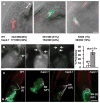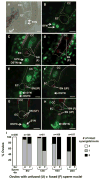Gamete fusion is required to block multiple pollen tubes from entering an Arabidopsis ovule
- PMID: 22608506
- PMCID: PMC3973743
- DOI: 10.1016/j.cub.2012.04.041
Gamete fusion is required to block multiple pollen tubes from entering an Arabidopsis ovule
Abstract
In double fertilization, a reproductive system unique to flowering plants, two immotile sperm are delivered to an ovule by a pollen tube. One sperm fuses with the egg to generate a zygote, the other with the central cell to produce endosperm. A mechanism preventing multiple pollen tubes from entering an ovule would ensure that only two sperm are delivered to female gametes. We use live-cell imaging and a novel mixed-pollination assay that can detect multiple pollen tubes and multiple sets of sperm within a single ovule to show that Arabidopsis efficiently prevents multiple pollen tubes from entering an ovule. However, when gamete-fusion defective hap2(gcs1) or duo1 sperm are delivered to ovules, as many as three additional pollen tubes are attracted. When gamete fusion fails, one of two pollen tube-attracting synergid cells persists, enabling the ovule to attract more pollen tubes for successful fertilization. This mechanism prevents the delivery of more than one pair of sperm to an ovule, provides a means of salvaging fertilization in ovules that have received defective sperm, and ensures maximum reproductive success by distributing pollen tubes to all ovules.
Copyright © 2012 Elsevier Ltd. All rights reserved.
Figures


Comment in
-
Plant fertilization: maximizing reproductive success.Curr Biol. 2012 Jun 19;22(12):R487-9. doi: 10.1016/j.cub.2012.04.048. Curr Biol. 2012. PMID: 22720682
References
-
- Berger F, Hamamura Y, Ingouff M, Higashiyama T. Double fertilization - caught in the act. Trends Plant Sci. 2008;13:437–443. - PubMed
-
- Hamamura Y, Saito C, Awai C, Kurihara D, Miyawaki A, Nakagawa T, Kanaoka MM, Sasaki N, Nakano A, Berger F, et al. Live-Cell Imaging Reveals the Dynamics of Two Sperm Cells during Double Fertilization in Arabidopsis thaliana. Curr Biol. 2011;21:497–502. - PubMed
-
- Wong JL, Wessel GM. Defending the zygote: search for the ancestral animal block to polyspermy. Curr Top Dev Biol. 2006;72:1–151. - PubMed
-
- Twell D, Yamaguchi J, McCormick S. Pollen-specific gene expression in transgenic plants: coordinate regulation of two different tomato gene promoters during microsporogenesis. Development (Cambridge, England) 1990;109:705–713. - PubMed
Publication types
MeSH terms
Substances
Grants and funding
LinkOut - more resources
Full Text Sources
Molecular Biology Databases

